May 26, 2025 | 15:45 GMT +7
May 26, 2025 | 15:45 GMT +7
Hotline: 0913.378.918
May 26, 2025 | 15:45 GMT +7
Hotline: 0913.378.918
Many people say that the situation of using fertilizers and pesticides in the Central Highlands had improved a lot in recent years, but during the field trip of the journalists of Vietnam Agriculture News in many regions, the situation is still very alarming, showing that the goal towards green, responsible and sustainable agriculture is still quite far away.
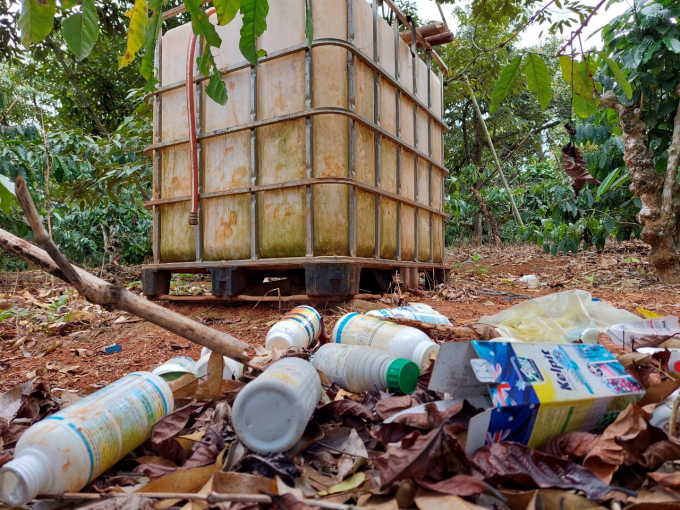
Containers of toxic pesticides in a durian orchard in Krong Pak. Photo: Minh Quy.
According to statistics, Dak Lak currently has about 12,000 ha of durian, of which Krong Pak district is a key production, purchasing and processing area of the whole Central Highlands region with more than 3,800 ha and an output of over 50,000 tons/year. Approximately two weeks ago, the National Office of Intellectual Property (Ministry of Science and Technology) and Dak Lak People's Committee held a certificate of collective trademark registration for "Krong Pac Durian".
With over 600 ha of VietGAP-certified and over 730 ha of planting area codes granted by the Department of Plant Protection, Dak Lak’s agriculture industry and durian growers expect Krong Pak durian not only to be able to serve the domestic market but will soon be available in the most demanding export markets.
But it will be hard to realize that ambition if we witness what is happening in the durian orchards entering the flowering and fruiting stage in this land.
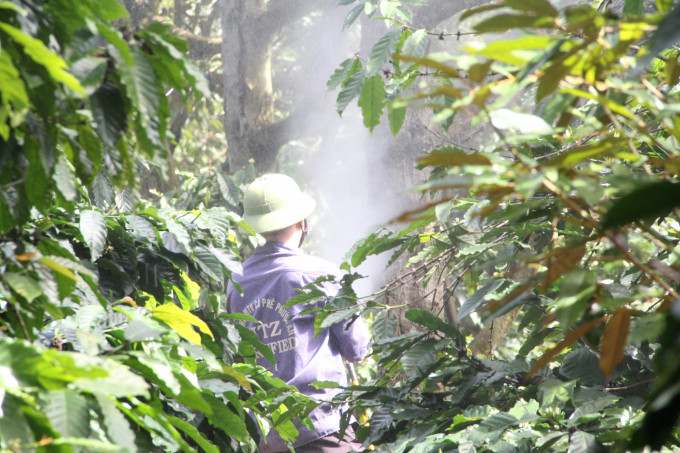
Durian orchards are "bathing" in pesticides. Photo: Minh Quy.
Using power from the plow itself, in just one morning, Mr. Nguyen Phi Hong's tens of meters long nozzle sprayed the nearly 1 ha wide durian garden. Pesticide BOXING (aphid knockout type) covered the whole sky, and those standing hundreds of meters away could still feel heavily dizzy because of the smell.
All kinds of pesticides and fertilizers were there: From pesticides to flower stimulants, root fertilizers, foliar growth stimulants. The pressure of productivity and output makes people defy everything to spray, irrigate, even inject drugs and manure for plants. Walking along the gardens, we encountered scenes of durian trees fully stuck with needles. Durian growers said that these were drugs to treat tree diseases such as sap oozing and latex leaking. They must be injected directly like that, and twice a year so that the effects could kick in.
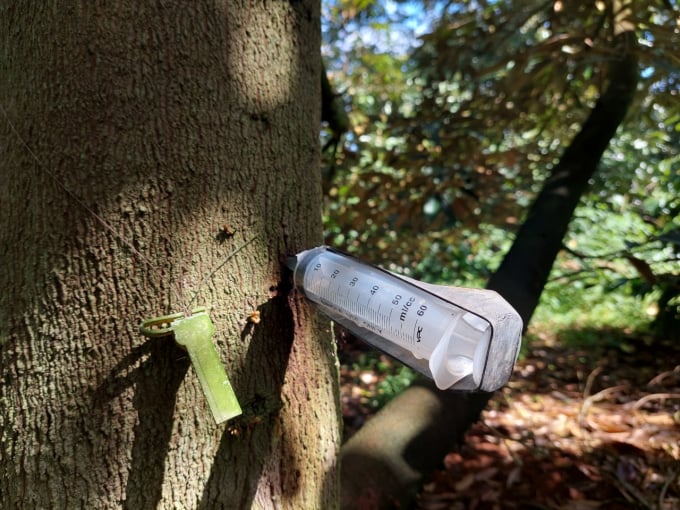
Injecting drugs into durian trees. Photo: Minh Quy.
“They are all chemicals,” said Nguyen Van Tung, a young grower owning more than 1 ha of durian in Ea Yong commune. According to preliminary calculations, each ha of durian growing land in Ea Yong must suffer tens of thousands of liters of pesticides and dozens of tons of chemical fertilizers in just one crop. An entire durian area of nearly 4,000 ha received millions of liters of drugs.
It was no different than a giant “poison warehouse”. Despite having continuously discarded bottles and packages after each spraying and fertilizing session, the pesticide bottle container area in Nguyen Van Tung's durian orchard was filled up full, so much that they were scattered all over the garden. This area had been cleared once just half a month ago. All kinds of plant protection drugs were there: insecticide FOR TOX 50EC with high toxicity; the quick-absorption and spider-repellant Calicydan 150 EW; insecticide Imiprid 10WP combining two over-powered active ingredients to kill planthoppers, so many that Tung could no longer differentiate.
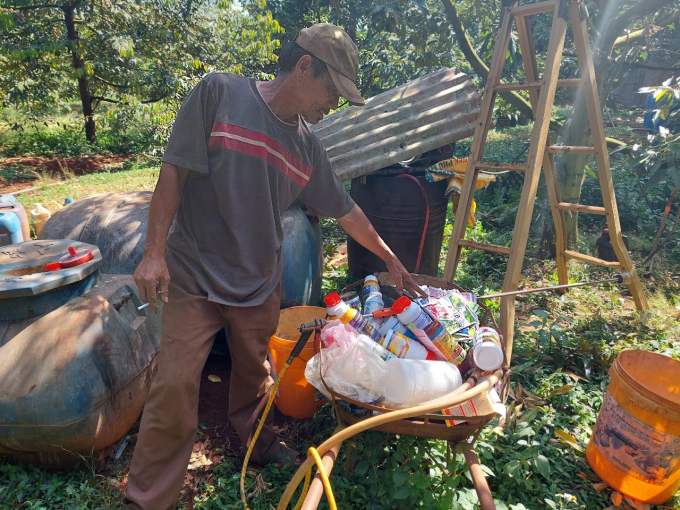
After only a few weeks, the pesticide container area was piled up. Photo: Minh Quy.
One thing to note was that we also encountered many pesticide products having Thai on the packaging. Owners of business agents and regulatory agencies all confirmed that these drugs were either smuggled or fake. "Are you not afraid of health effects when spraying and fertilizing like that?" Ten out of ten people said they were indeed afraid, but when we asked why they didn't switch to using biological drugs for safety, noone could answer.
Not only ordinary farming households, but even VietGAP also certified durian models in Krong Pak are flooded with chemical pesticides and fertilizers.
The 0.93 ha durian garden of Mr. Le Quang Luyen's family has been assessed and certified VietGAP since 2019 by Cafe Control Co. The orchard owner however confirmed that he had sprayed three times this year, mainly with flower stimulants, super fruiting agents, and super insecticides against aphids.

Giant pesticide container in a VietGAP orchard. Photo: Minh Quy.
Mr. Vinh himself admitted that although the orchard was VietGAP certified, the certification body only came down to inspect sometimes. “Two years ago the local authorities worked very strictly. When the durian was about to be harvested, the units would send technicians to get the fruit for testing. But in these two years, perhaps due to the Covid-19 epidemic we did not see any technician coming down here.”
Although certified as a VietGAP garden, Mr. Vinh's family spent more than VND 100 million per year on average on fertilizers and pesticides. The application process was not much different from the usual when they had to spray pesticides once every 10 days, and "chemical pesticide is a must".
Acknowledging the chemical fertilizers and pesticides abuse in durian growing areas in Krong Pak, Mr. Doan Doan Toan, Deputy Head of Krong Pak Office of Agriculture, said, “Recommendations and proposals are plenty, but it is true that people would still risk it all for profit. There are objective reasons of course, such as durian trees have many diseases that only one drug cannot cure fully, forcing people to use other drugs. They just keep buying from all sources they could possibly find. But there are also true issues that we raised but people just don't listen."
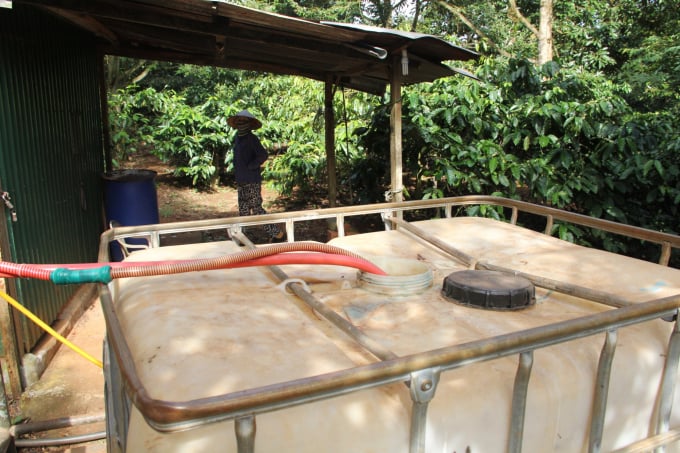
Excessive use of fertilizers and pesticides is "poisoning" the key durian area in the Central Highlands. Photo: Minh Quy.
As a result, three years ago Krong Pak had over 100 ha of durian growing area died at a time. The risk is even more evident when many durian orchards only flower on the outside of the branch, but rarely on the trunk.
Through evaluation in the past 10 years, some obvious signs included: the physical properties of the soil have changed, the soil has been degraded and degraded a lot, the porosity and fertility of the soil are no longer the same as before.
After years of fertilizers and pesticides abuse, many soil samples in the Central Highlands brought have become so acidic that it is no longer suitable for crops. The pH is too low. Normally, for common crops in the region, such as coffee and pepper, the suitable pH ranges from 4.5 to 6.5. However, in many areas today, the soil is washed away due to the excessive use of inputs, causing the soil pH to drop below 4. This is a major problem. If there is no solution, a lot of land in the Central Highlands may become impossible to cultivate.
Dr. Phan Viet Ha, Western Highlands Agriculture and Forestry Science Institute (WASI)
Translated by Samuel Pham
/2025/05/25/4127-3-073637_820.jpg)
(VAN) Thanks to the promotion from an FAO-implemented project, vegetable production in greenhouses in Moc Chau has seen strong development, from 1.5 hectares in 2021 to nearly 50 hectares in 2024.

(VAN) FAO has recently supported USD 140,000 to implement the project 'Risk mitigation human-animal interface risks through disease control initiatives in pig farming.'

(VAN) The People's Committee of Tra Vinh province has approved an adjustment to the investment policy for the Green Hydrogen Plant project, increasing its area to approximately 52.76 hectares.
![Reducing emissions from rice fields: [2] Farmers’ commitment to the soil](https://t.ex-cdn.com/nongnghiepmoitruong.vn/608w/files/news/2025/05/05/dsc08881jpg-nongnghiep-140632.jpg)
(VAN) Clean rice cultivation model in Thuong Tan commune, Bac Tan Uyen district, is assisting local residents in achieving sustainable agriculture by substantially reducing costs, increasing productivity, and protecting the environment.

(VAN) At the conference to disseminate Resolution No. 68, AgriS introduced its digital agricultural ecosystem and reaffirmed its commitment to accompanying the Government in promoting private sector development and sustainable agriculture.

(VAN) 'Blue Ocean - Blue Foods' initiative is designed to restore marine ecosystems and establish sustainable livelihoods for local communities by cultivating a minimum of 1,000 hectares of cottonii seaweed in the first three years.
/2025/05/21/4642-3-112707_603.jpg)
(VAN) The V-SCOPE project has made direct contributions to three out of six pillars of the Comprehensive Strategic Partnership between Vietnam and Australia.